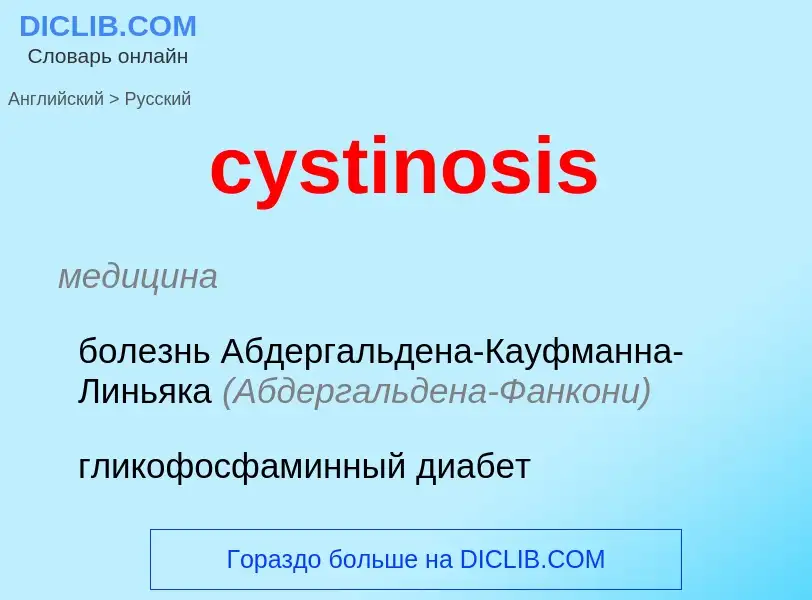Übersetzung und Analyse von Wörtern durch künstliche Intelligenz ChatGPT
Auf dieser Seite erhalten Sie eine detaillierte Analyse eines Wortes oder einer Phrase mithilfe der besten heute verfügbaren Technologie der künstlichen Intelligenz:
- wie das Wort verwendet wird
- Häufigkeit der Nutzung
- es wird häufiger in mündlicher oder schriftlicher Rede verwendet
- Wortübersetzungsoptionen
- Anwendungsbeispiele (mehrere Phrasen mit Übersetzung)
- Etymologie
cystinosis - Übersetzung nach russisch
медицина
болезнь Абдергальдена-Кауфманна-Линьяка (Абдергальдена-Фанкони)
гликофосфаминный диабет
синдром Абдергальдена-Фанкони
цистиноз
медицина
болезнь Абдергальдена-Кауфманна-Линьяка (Абдергальдена-Фанкони)
гликофосфаминный диабет
Wikipedia

Cystinosis is a lysosomal storage disease characterized by the abnormal accumulation of cystine, the oxidized dimer of the amino acid cysteine. It is a genetic disorder that follows an autosomal recessive inheritance pattern. It is a rare autosomal recessive disorder resulting from accumulation of free cystine in lysosomes, eventually leading to intracellular crystal formation throughout the body. Cystinosis is the most common cause of Fanconi syndrome in the pediatric age group. Fanconi syndrome occurs when the function of cells in renal tubules is impaired, leading to abnormal amounts of carbohydrates and amino acids in the urine, excessive urination, and low blood levels of potassium and phosphates.
Cystinosis was the first documented genetic disease belonging to the group of lysosomal storage disease disorders. Cystinosis is caused by mutations in the CTNS gene that codes for cystinosin, the lysosomal membrane-specific transporter for cystine. Intracellular metabolism of cystine, as it happens with all amino acids, requires its transport across the cell membrane. After degradation of endocytosed protein to cystine within lysosomes, it is normally transported to the cytosol. But if there is a defect in the carrier protein, cystine is accumulated in lysosomes. As cystine is highly insoluble, when its concentration in tissue lysosomes increases, its solubility is immediately exceeded and crystalline precipitates are formed in almost all organs and tissues.
However, the progression of the disease is not related to the presence of crystals in target tissues. Although tissue damage might depend on cystine accumulation, the mechanisms of tissue damage are not fully understood. Increased intracellular cystine profoundly disturbs cellular oxidative metabolism and glutathione status, leading to altered mitochondrial energy metabolism, autophagy, and apoptosis.
Cystinosis is usually treated with cysteamine, which is prescribed to decrease intralysosomal cystine accumulation. However, the discovery of new pathogenic mechanisms and the development of an animal model of the disease may open possibilities for the development of new treatment modalities to improve long-term prognosis.



